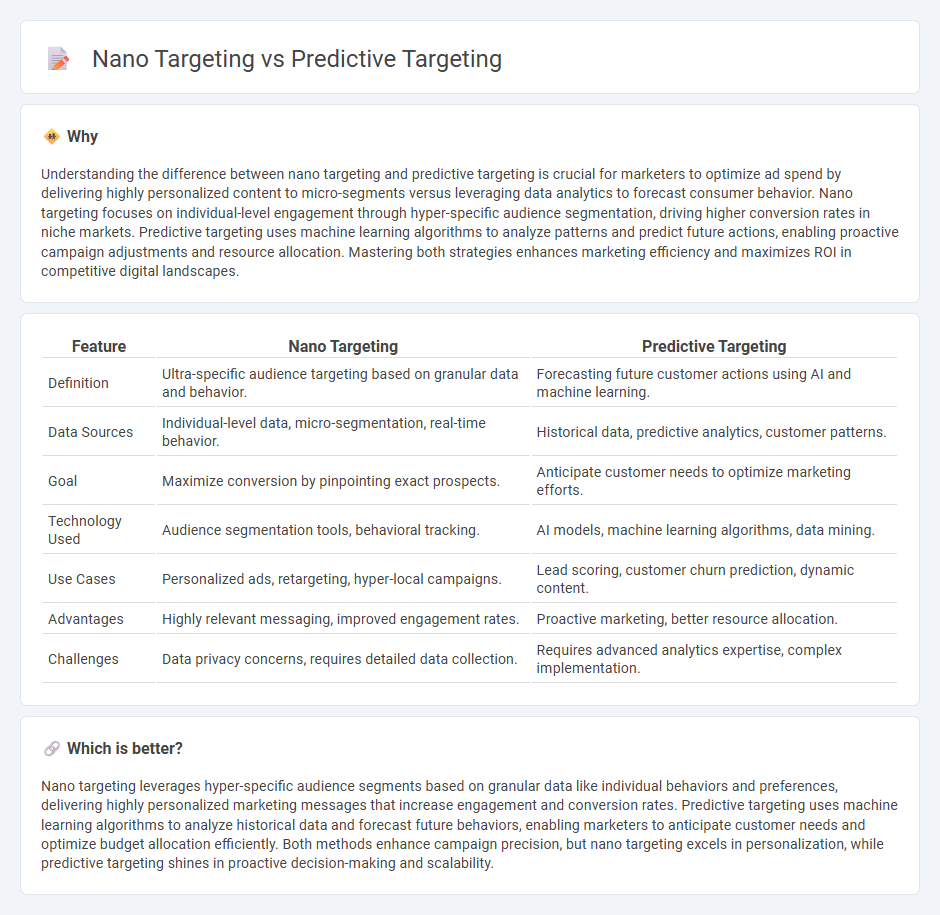
Nano targeting focuses on hyper-personalized marketing by analyzing minute audience segments, delivering tailored content to specific individuals. Predictive targeting uses data analytics and machine learning to forecast consumer behavior and optimize ad placements for higher conversion rates. Explore the key differences and advantages to enhance your marketing strategy.
Why it is important
Understanding the difference between nano targeting and predictive targeting is crucial for marketers to optimize ad spend by delivering highly personalized content to micro-segments versus leveraging data analytics to forecast consumer behavior. Nano targeting focuses on individual-level engagement through hyper-specific audience segmentation, driving higher conversion rates in niche markets. Predictive targeting uses machine learning algorithms to analyze patterns and predict future actions, enabling proactive campaign adjustments and resource allocation. Mastering both strategies enhances marketing efficiency and maximizes ROI in competitive digital landscapes.
Comparison Table
| Feature | Nano Targeting | Predictive Targeting |
|---|---|---|
| Definition | Ultra-specific audience targeting based on granular data and behavior. | Forecasting future customer actions using AI and machine learning. |
| Data Sources | Individual-level data, micro-segmentation, real-time behavior. | Historical data, predictive analytics, customer patterns. |
| Goal | Maximize conversion by pinpointing exact prospects. | Anticipate customer needs to optimize marketing efforts. |
| Technology Used | Audience segmentation tools, behavioral tracking. | AI models, machine learning algorithms, data mining. |
| Use Cases | Personalized ads, retargeting, hyper-local campaigns. | Lead scoring, customer churn prediction, dynamic content. |
| Advantages | Highly relevant messaging, improved engagement rates. | Proactive marketing, better resource allocation. |
| Challenges | Data privacy concerns, requires detailed data collection. | Requires advanced analytics expertise, complex implementation. |
Which is better?
Nano targeting leverages hyper-specific audience segments based on granular data like individual behaviors and preferences, delivering highly personalized marketing messages that increase engagement and conversion rates. Predictive targeting uses machine learning algorithms to analyze historical data and forecast future behaviors, enabling marketers to anticipate customer needs and optimize budget allocation efficiently. Both methods enhance campaign precision, but nano targeting excels in personalization, while predictive targeting shines in proactive decision-making and scalability.
Connection
Nano targeting and predictive targeting are interconnected through their reliance on granular data analysis to enhance marketing precision. Nano targeting focuses on engaging extremely small, specific audience segments, while predictive targeting uses algorithms and historical data to forecast future consumer behaviors. The integration of these approaches allows marketers to deliver highly personalized content with greater accuracy, maximizing engagement and conversion rates.
Key Terms
**Predictive Targeting:**
Predictive targeting leverages advanced data analytics and machine learning algorithms to anticipate consumer behavior and optimize ad placements for maximum engagement and conversion rates. Unlike nano targeting, which focuses on narrowly defined micro-segments, predictive targeting uses broader data patterns to forecast future trends and personalize marketing strategies at scale. Explore the benefits of predictive targeting to enhance your advertising ROI and customer acquisition efforts.
Data Analytics
Predictive targeting leverages historical data and advanced algorithms to forecast consumer behavior and optimize marketing strategies, driving higher conversion rates through data-driven insights. Nano targeting, on the other hand, emphasizes hyper-localized and highly specific audience segments by analyzing granular data points such as individual preferences and real-time interactions. Explore the nuances of data analytics in these approaches to enhance precision marketing effectiveness.
Machine Learning
Predictive targeting leverages machine learning algorithms to analyze large datasets, identifying patterns and forecasting consumer behavior for refined audience segmentation. Nano targeting uses similar ML techniques but narrows the focus to hyper-specific, micro-segments, enabling personalized marketing efforts at an individual or ultra-local level. Explore more to understand how these advanced targeting strategies optimize campaign performance through AI-driven insights.
Source and External Links
Exploring Predictive Behavioral Targeting: What It Is and How It Works - Predictive targeting uses machine learning and AI to analyze past user behavior and predict future actions to deliver personalized ads at the optimal time without compromising privacy.
Predictive models for targeting - The Cambridge Group - Predictive targeting applies in-depth analytics to score customer segments from CRM or external data to enable precise 1-to-1 marketing, allowing tailored communications and customized experiences.
Predictive Audiences: What They Are, How They Work - Taboola.com - Predictive targeting leverages AI, big data, and modeling to anticipate which users are most likely to convert, enabling marketers to reach customers with personalized content at the right moment and improve ROI.
 dowidth.com
dowidth.com